Strategies for Health Promotion Awareness on Depression in Singapore
VerifiedAdded on 2023/04/25
|9
|2189
|450
Report
AI Summary
This report addresses the significant issue of depression among youths aged 18-30 in Singapore, highlighting its prevalence, causes, and impact. The report draws on statistics from the World Health Organization and local research to illustrate the severity of the problem, including high suicide rates. It explores contributing factors such as social media pressures, academic competition, and family problems. Furthermore, the report identifies the target group, the age bracket of 18-30, and emphasizes the need for health promotion strategies. Key areas for intervention include strengthening community action, developing personal skills, and reorienting health services. The report suggests strategies to manage and prevent depression, such as regular exercise, medication, good sleep, and therapy. The conclusion underscores the urgency of addressing this mental health crisis and promotes the development of effective strategies to support the well-being of young people in Singapore. The report also provides references to the sources of information used in the research.
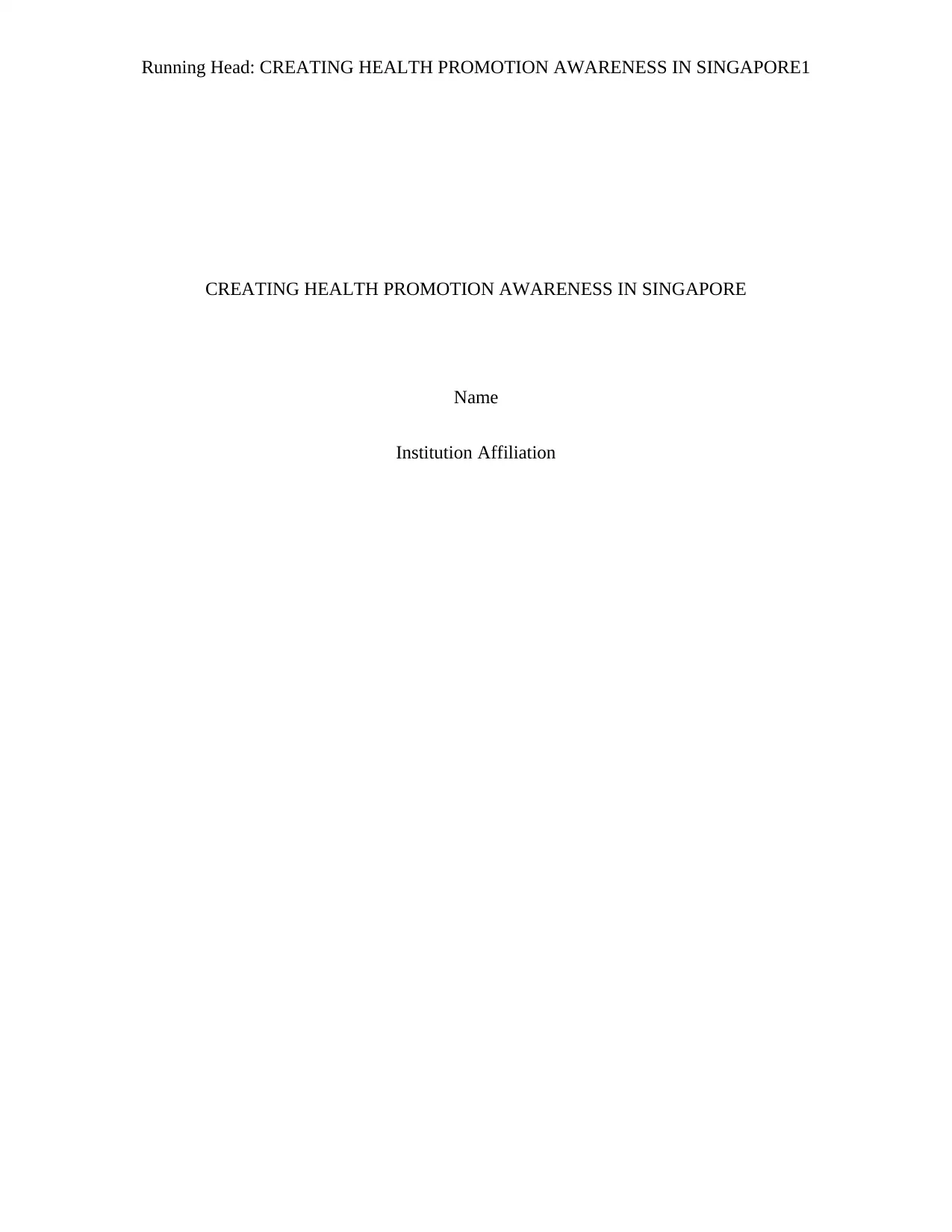
Running Head: CREATING HEALTH PROMOTION AWARENESS IN SINGAPORE1
CREATING HEALTH PROMOTION AWARENESS IN SINGAPORE
Name
Institution Affiliation
CREATING HEALTH PROMOTION AWARENESS IN SINGAPORE
Name
Institution Affiliation
Paraphrase This Document
Need a fresh take? Get an instant paraphrase of this document with our AI Paraphraser
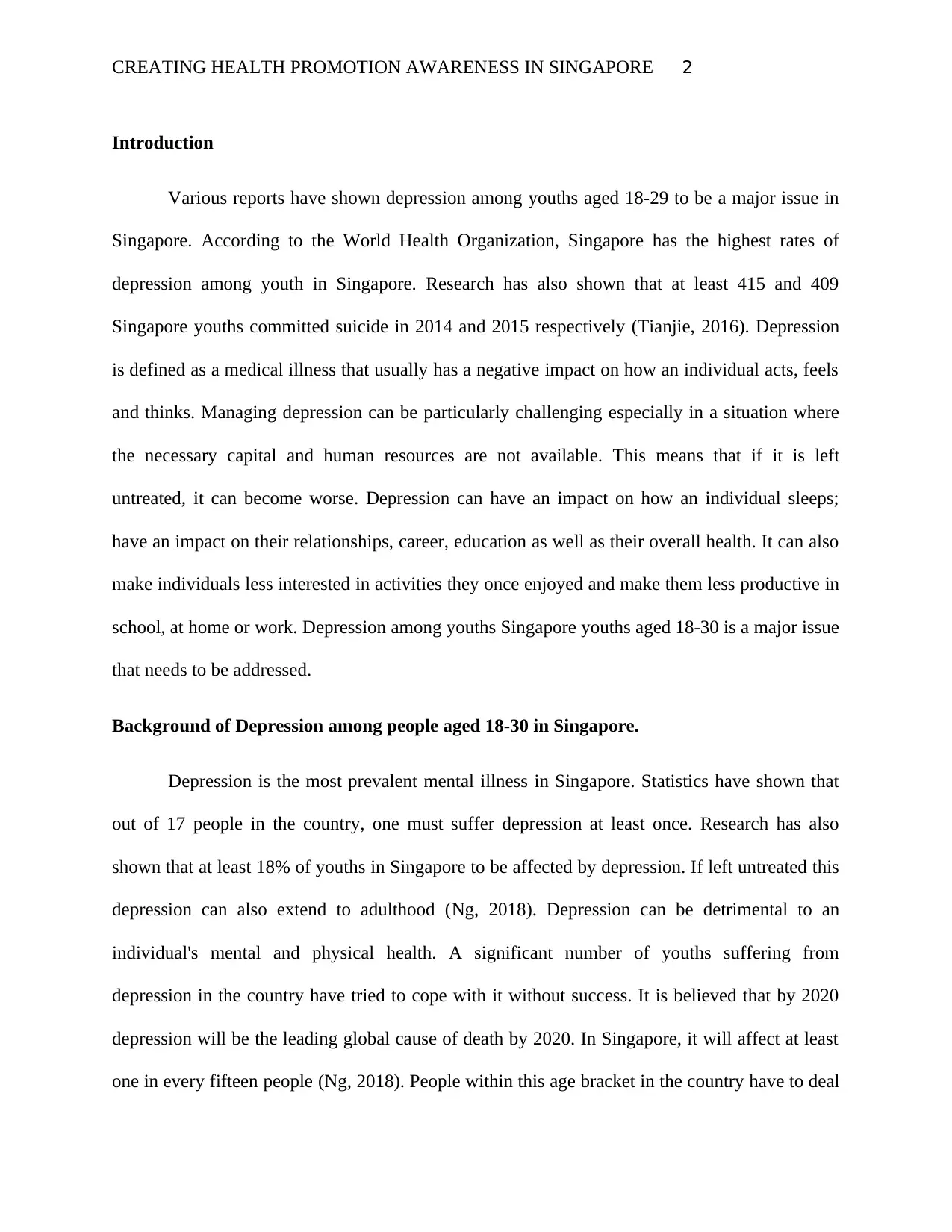
CREATING HEALTH PROMOTION AWARENESS IN SINGAPORE 2
Introduction
Various reports have shown depression among youths aged 18-29 to be a major issue in
Singapore. According to the World Health Organization, Singapore has the highest rates of
depression among youth in Singapore. Research has also shown that at least 415 and 409
Singapore youths committed suicide in 2014 and 2015 respectively (Tianjie, 2016). Depression
is defined as a medical illness that usually has a negative impact on how an individual acts, feels
and thinks. Managing depression can be particularly challenging especially in a situation where
the necessary capital and human resources are not available. This means that if it is left
untreated, it can become worse. Depression can have an impact on how an individual sleeps;
have an impact on their relationships, career, education as well as their overall health. It can also
make individuals less interested in activities they once enjoyed and make them less productive in
school, at home or work. Depression among youths Singapore youths aged 18-30 is a major issue
that needs to be addressed.
Background of Depression among people aged 18-30 in Singapore.
Depression is the most prevalent mental illness in Singapore. Statistics have shown that
out of 17 people in the country, one must suffer depression at least once. Research has also
shown that at least 18% of youths in Singapore to be affected by depression. If left untreated this
depression can also extend to adulthood (Ng, 2018). Depression can be detrimental to an
individual's mental and physical health. A significant number of youths suffering from
depression in the country have tried to cope with it without success. It is believed that by 2020
depression will be the leading global cause of death by 2020. In Singapore, it will affect at least
one in every fifteen people (Ng, 2018). People within this age bracket in the country have to deal
Introduction
Various reports have shown depression among youths aged 18-29 to be a major issue in
Singapore. According to the World Health Organization, Singapore has the highest rates of
depression among youth in Singapore. Research has also shown that at least 415 and 409
Singapore youths committed suicide in 2014 and 2015 respectively (Tianjie, 2016). Depression
is defined as a medical illness that usually has a negative impact on how an individual acts, feels
and thinks. Managing depression can be particularly challenging especially in a situation where
the necessary capital and human resources are not available. This means that if it is left
untreated, it can become worse. Depression can have an impact on how an individual sleeps;
have an impact on their relationships, career, education as well as their overall health. It can also
make individuals less interested in activities they once enjoyed and make them less productive in
school, at home or work. Depression among youths Singapore youths aged 18-30 is a major issue
that needs to be addressed.
Background of Depression among people aged 18-30 in Singapore.
Depression is the most prevalent mental illness in Singapore. Statistics have shown that
out of 17 people in the country, one must suffer depression at least once. Research has also
shown that at least 18% of youths in Singapore to be affected by depression. If left untreated this
depression can also extend to adulthood (Ng, 2018). Depression can be detrimental to an
individual's mental and physical health. A significant number of youths suffering from
depression in the country have tried to cope with it without success. It is believed that by 2020
depression will be the leading global cause of death by 2020. In Singapore, it will affect at least
one in every fifteen people (Ng, 2018). People within this age bracket in the country have to deal
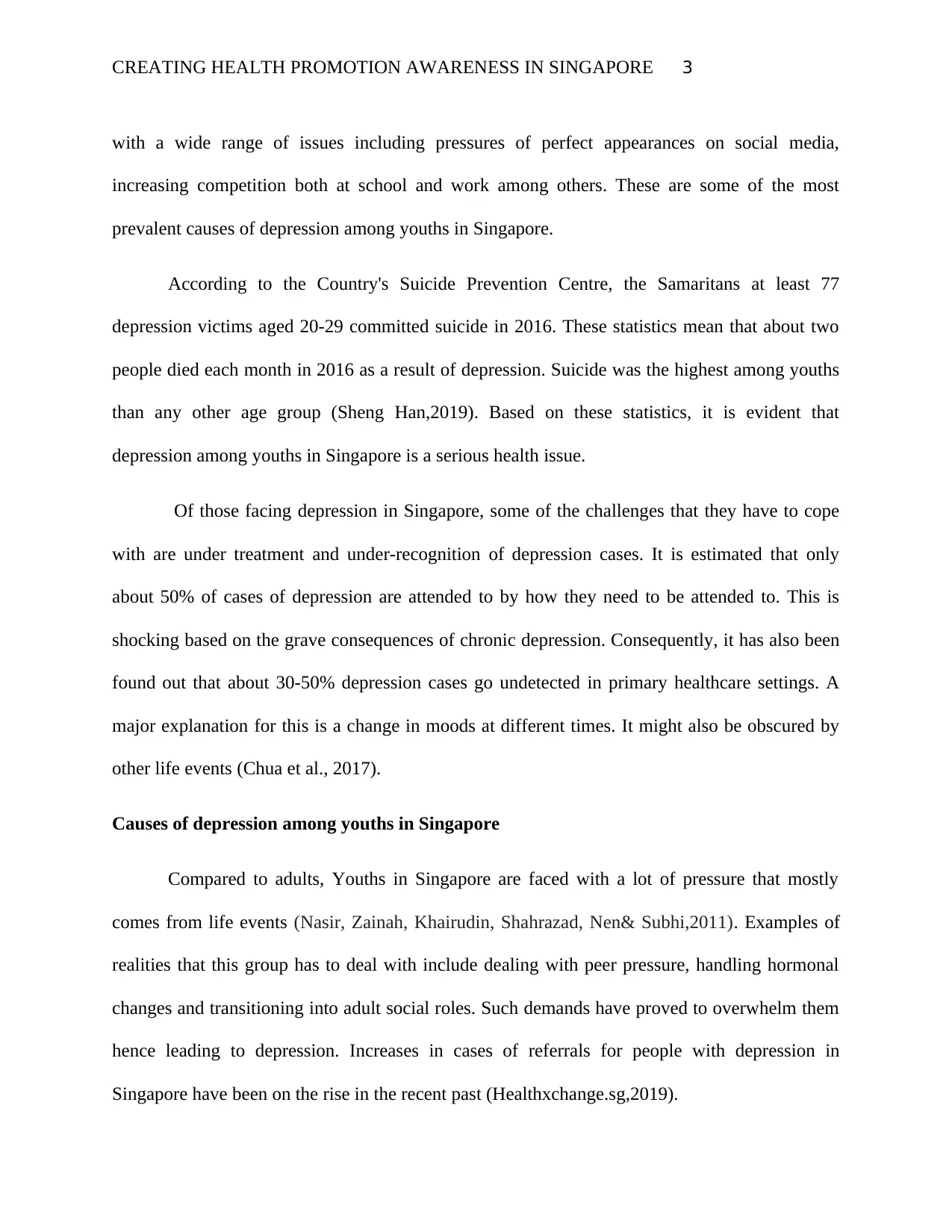
CREATING HEALTH PROMOTION AWARENESS IN SINGAPORE 3
with a wide range of issues including pressures of perfect appearances on social media,
increasing competition both at school and work among others. These are some of the most
prevalent causes of depression among youths in Singapore.
According to the Country's Suicide Prevention Centre, the Samaritans at least 77
depression victims aged 20-29 committed suicide in 2016. These statistics mean that about two
people died each month in 2016 as a result of depression. Suicide was the highest among youths
than any other age group (Sheng Han,2019). Based on these statistics, it is evident that
depression among youths in Singapore is a serious health issue.
Of those facing depression in Singapore, some of the challenges that they have to cope
with are under treatment and under-recognition of depression cases. It is estimated that only
about 50% of cases of depression are attended to by how they need to be attended to. This is
shocking based on the grave consequences of chronic depression. Consequently, it has also been
found out that about 30-50% depression cases go undetected in primary healthcare settings. A
major explanation for this is a change in moods at different times. It might also be obscured by
other life events (Chua et al., 2017).
Causes of depression among youths in Singapore
Compared to adults, Youths in Singapore are faced with a lot of pressure that mostly
comes from life events (Nasir, Zainah, Khairudin, Shahrazad, Nen& Subhi,2011). Examples of
realities that this group has to deal with include dealing with peer pressure, handling hormonal
changes and transitioning into adult social roles. Such demands have proved to overwhelm them
hence leading to depression. Increases in cases of referrals for people with depression in
Singapore have been on the rise in the recent past (Healthxchange.sg,2019).
with a wide range of issues including pressures of perfect appearances on social media,
increasing competition both at school and work among others. These are some of the most
prevalent causes of depression among youths in Singapore.
According to the Country's Suicide Prevention Centre, the Samaritans at least 77
depression victims aged 20-29 committed suicide in 2016. These statistics mean that about two
people died each month in 2016 as a result of depression. Suicide was the highest among youths
than any other age group (Sheng Han,2019). Based on these statistics, it is evident that
depression among youths in Singapore is a serious health issue.
Of those facing depression in Singapore, some of the challenges that they have to cope
with are under treatment and under-recognition of depression cases. It is estimated that only
about 50% of cases of depression are attended to by how they need to be attended to. This is
shocking based on the grave consequences of chronic depression. Consequently, it has also been
found out that about 30-50% depression cases go undetected in primary healthcare settings. A
major explanation for this is a change in moods at different times. It might also be obscured by
other life events (Chua et al., 2017).
Causes of depression among youths in Singapore
Compared to adults, Youths in Singapore are faced with a lot of pressure that mostly
comes from life events (Nasir, Zainah, Khairudin, Shahrazad, Nen& Subhi,2011). Examples of
realities that this group has to deal with include dealing with peer pressure, handling hormonal
changes and transitioning into adult social roles. Such demands have proved to overwhelm them
hence leading to depression. Increases in cases of referrals for people with depression in
Singapore have been on the rise in the recent past (Healthxchange.sg,2019).
⊘ This is a preview!⊘
Do you want full access?
Subscribe today to unlock all pages.

Trusted by 1+ million students worldwide
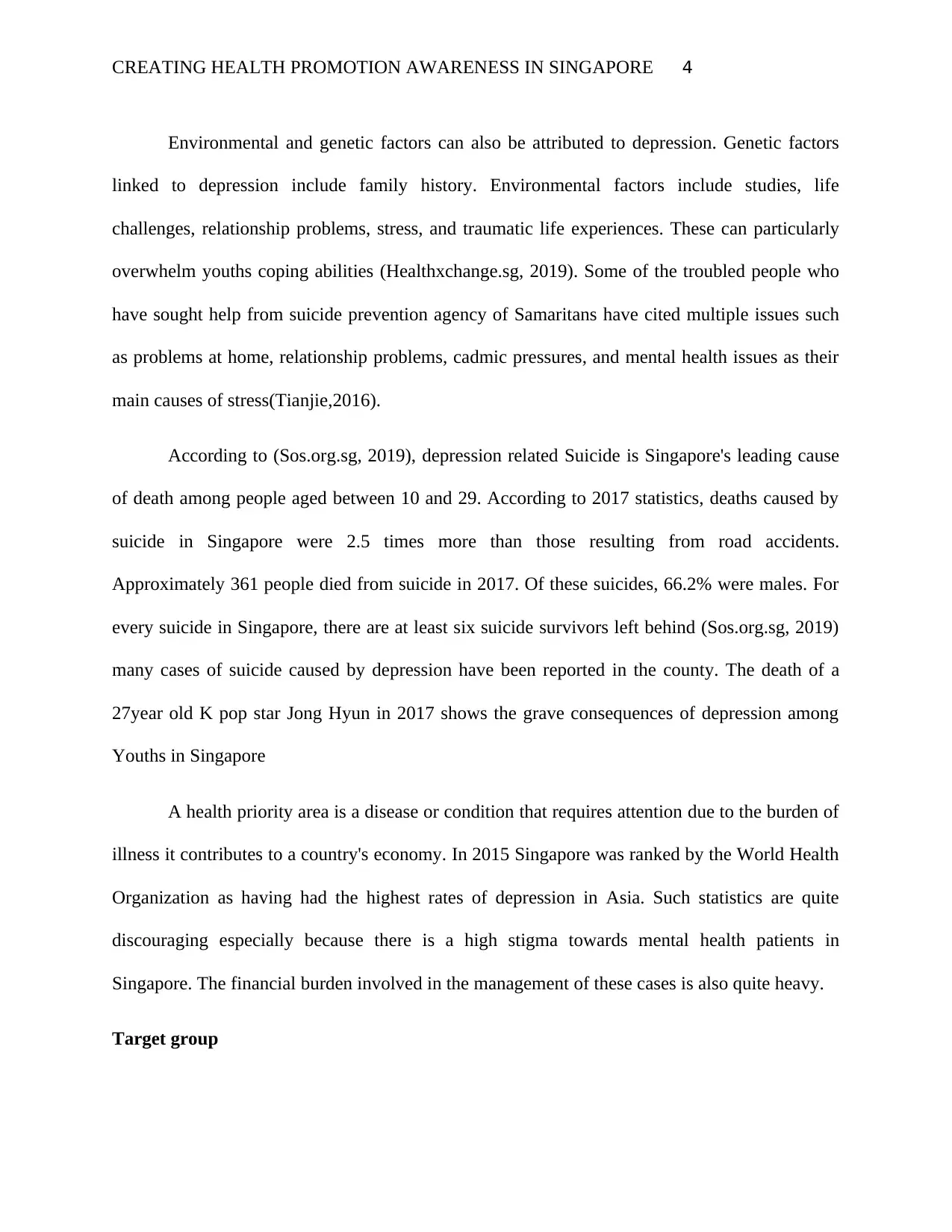
CREATING HEALTH PROMOTION AWARENESS IN SINGAPORE 4
Environmental and genetic factors can also be attributed to depression. Genetic factors
linked to depression include family history. Environmental factors include studies, life
challenges, relationship problems, stress, and traumatic life experiences. These can particularly
overwhelm youths coping abilities (Healthxchange.sg, 2019). Some of the troubled people who
have sought help from suicide prevention agency of Samaritans have cited multiple issues such
as problems at home, relationship problems, cadmic pressures, and mental health issues as their
main causes of stress(Tianjie,2016).
According to (Sos.org.sg, 2019), depression related Suicide is Singapore's leading cause
of death among people aged between 10 and 29. According to 2017 statistics, deaths caused by
suicide in Singapore were 2.5 times more than those resulting from road accidents.
Approximately 361 people died from suicide in 2017. Of these suicides, 66.2% were males. For
every suicide in Singapore, there are at least six suicide survivors left behind (Sos.org.sg, 2019)
many cases of suicide caused by depression have been reported in the county. The death of a
27year old K pop star Jong Hyun in 2017 shows the grave consequences of depression among
Youths in Singapore
A health priority area is a disease or condition that requires attention due to the burden of
illness it contributes to a country's economy. In 2015 Singapore was ranked by the World Health
Organization as having had the highest rates of depression in Asia. Such statistics are quite
discouraging especially because there is a high stigma towards mental health patients in
Singapore. The financial burden involved in the management of these cases is also quite heavy.
Target group
Environmental and genetic factors can also be attributed to depression. Genetic factors
linked to depression include family history. Environmental factors include studies, life
challenges, relationship problems, stress, and traumatic life experiences. These can particularly
overwhelm youths coping abilities (Healthxchange.sg, 2019). Some of the troubled people who
have sought help from suicide prevention agency of Samaritans have cited multiple issues such
as problems at home, relationship problems, cadmic pressures, and mental health issues as their
main causes of stress(Tianjie,2016).
According to (Sos.org.sg, 2019), depression related Suicide is Singapore's leading cause
of death among people aged between 10 and 29. According to 2017 statistics, deaths caused by
suicide in Singapore were 2.5 times more than those resulting from road accidents.
Approximately 361 people died from suicide in 2017. Of these suicides, 66.2% were males. For
every suicide in Singapore, there are at least six suicide survivors left behind (Sos.org.sg, 2019)
many cases of suicide caused by depression have been reported in the county. The death of a
27year old K pop star Jong Hyun in 2017 shows the grave consequences of depression among
Youths in Singapore
A health priority area is a disease or condition that requires attention due to the burden of
illness it contributes to a country's economy. In 2015 Singapore was ranked by the World Health
Organization as having had the highest rates of depression in Asia. Such statistics are quite
discouraging especially because there is a high stigma towards mental health patients in
Singapore. The financial burden involved in the management of these cases is also quite heavy.
Target group
Paraphrase This Document
Need a fresh take? Get an instant paraphrase of this document with our AI Paraphraser
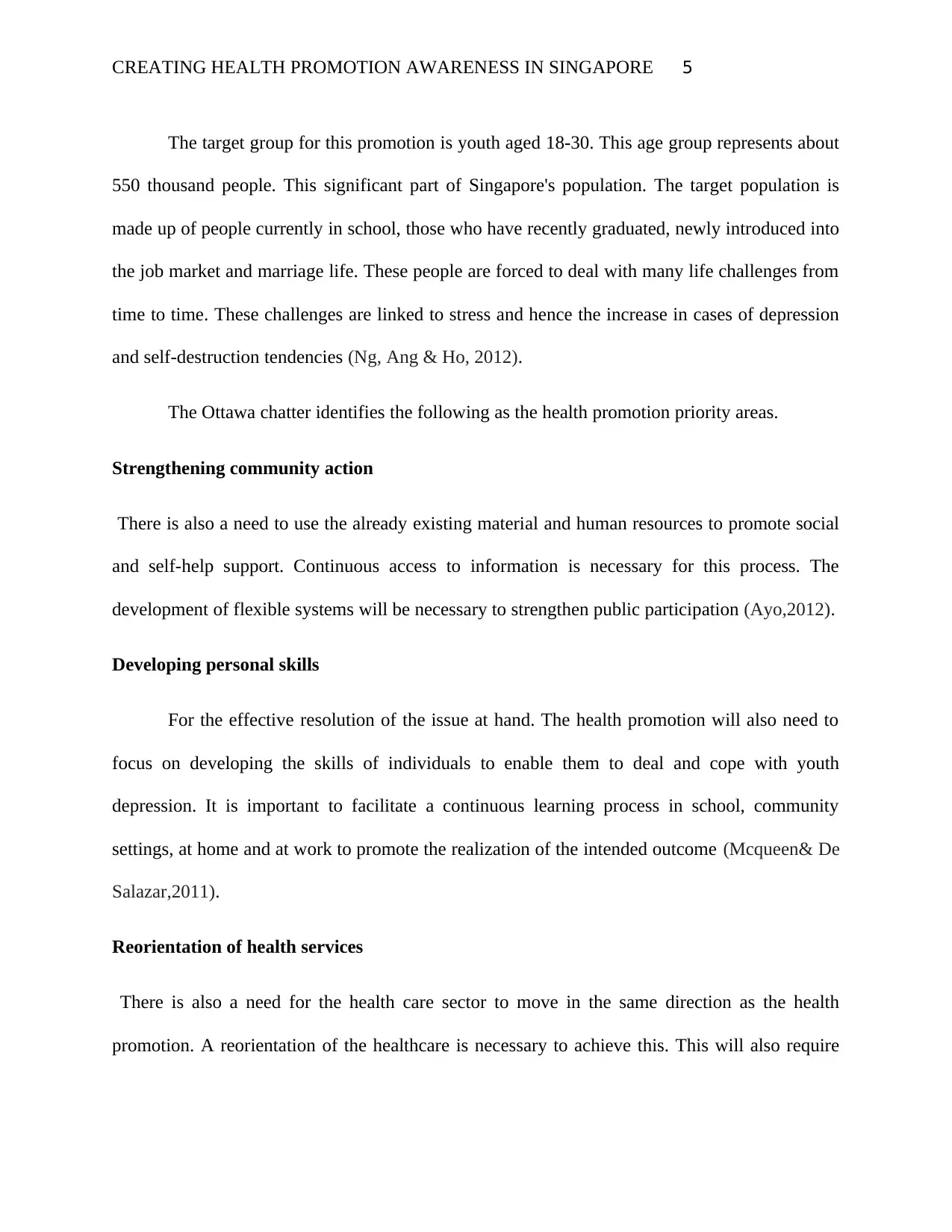
CREATING HEALTH PROMOTION AWARENESS IN SINGAPORE 5
The target group for this promotion is youth aged 18-30. This age group represents about
550 thousand people. This significant part of Singapore's population. The target population is
made up of people currently in school, those who have recently graduated, newly introduced into
the job market and marriage life. These people are forced to deal with many life challenges from
time to time. These challenges are linked to stress and hence the increase in cases of depression
and self-destruction tendencies (Ng, Ang & Ho, 2012).
The Ottawa chatter identifies the following as the health promotion priority areas.
Strengthening community action
There is also a need to use the already existing material and human resources to promote social
and self-help support. Continuous access to information is necessary for this process. The
development of flexible systems will be necessary to strengthen public participation (Ayo,2012).
Developing personal skills
For the effective resolution of the issue at hand. The health promotion will also need to
focus on developing the skills of individuals to enable them to deal and cope with youth
depression. It is important to facilitate a continuous learning process in school, community
settings, at home and at work to promote the realization of the intended outcome (Mcqueen& De
Salazar,2011).
Reorientation of health services
There is also a need for the health care sector to move in the same direction as the health
promotion. A reorientation of the healthcare is necessary to achieve this. This will also require
The target group for this promotion is youth aged 18-30. This age group represents about
550 thousand people. This significant part of Singapore's population. The target population is
made up of people currently in school, those who have recently graduated, newly introduced into
the job market and marriage life. These people are forced to deal with many life challenges from
time to time. These challenges are linked to stress and hence the increase in cases of depression
and self-destruction tendencies (Ng, Ang & Ho, 2012).
The Ottawa chatter identifies the following as the health promotion priority areas.
Strengthening community action
There is also a need to use the already existing material and human resources to promote social
and self-help support. Continuous access to information is necessary for this process. The
development of flexible systems will be necessary to strengthen public participation (Ayo,2012).
Developing personal skills
For the effective resolution of the issue at hand. The health promotion will also need to
focus on developing the skills of individuals to enable them to deal and cope with youth
depression. It is important to facilitate a continuous learning process in school, community
settings, at home and at work to promote the realization of the intended outcome (Mcqueen& De
Salazar,2011).
Reorientation of health services
There is also a need for the health care sector to move in the same direction as the health
promotion. A reorientation of the healthcare is necessary to achieve this. This will also require
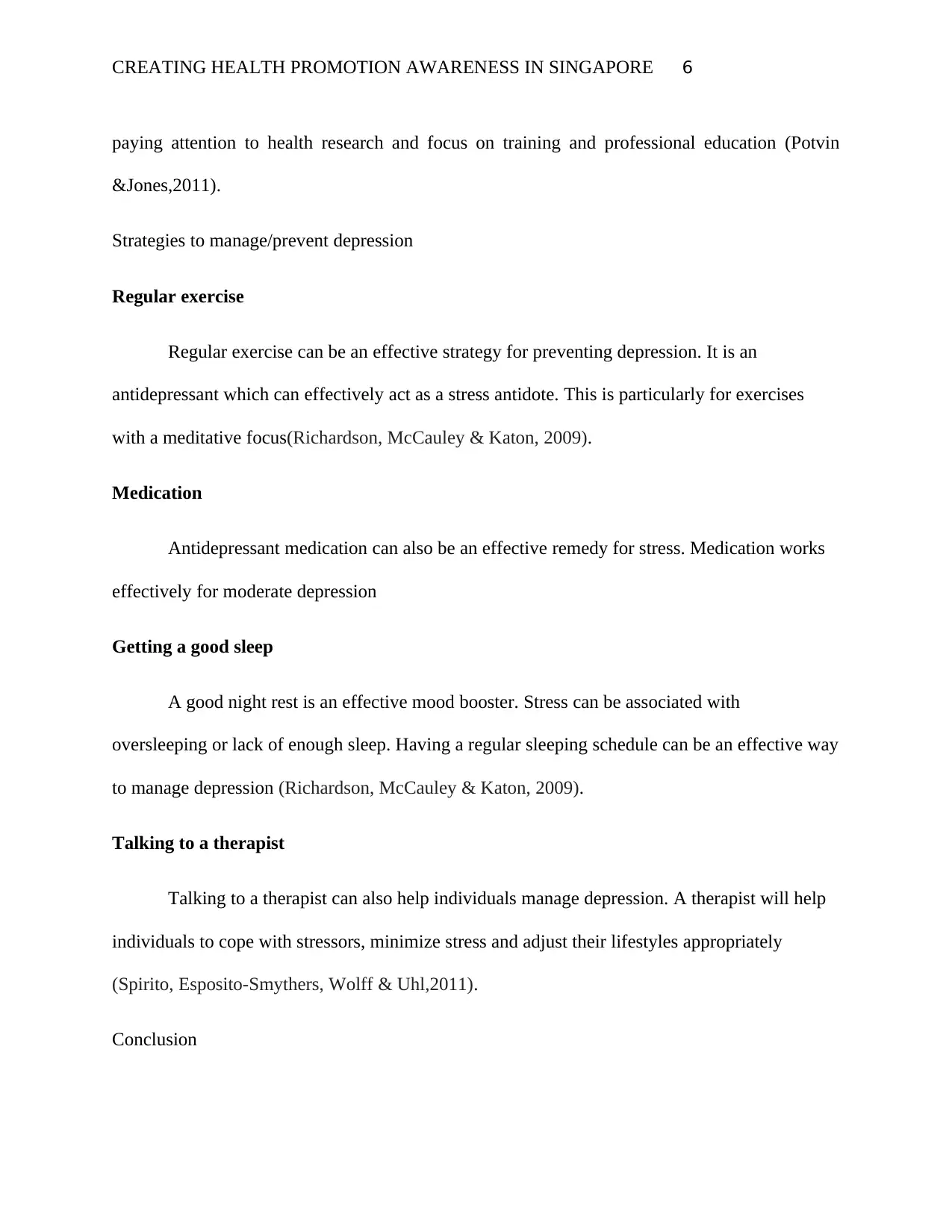
CREATING HEALTH PROMOTION AWARENESS IN SINGAPORE 6
paying attention to health research and focus on training and professional education (Potvin
&Jones,2011).
Strategies to manage/prevent depression
Regular exercise
Regular exercise can be an effective strategy for preventing depression. It is an
antidepressant which can effectively act as a stress antidote. This is particularly for exercises
with a meditative focus(Richardson, McCauley & Katon, 2009).
Medication
Antidepressant medication can also be an effective remedy for stress. Medication works
effectively for moderate depression
Getting a good sleep
A good night rest is an effective mood booster. Stress can be associated with
oversleeping or lack of enough sleep. Having a regular sleeping schedule can be an effective way
to manage depression (Richardson, McCauley & Katon, 2009).
Talking to a therapist
Talking to a therapist can also help individuals manage depression. A therapist will help
individuals to cope with stressors, minimize stress and adjust their lifestyles appropriately
(Spirito, Esposito-Smythers, Wolff & Uhl,2011).
Conclusion
paying attention to health research and focus on training and professional education (Potvin
&Jones,2011).
Strategies to manage/prevent depression
Regular exercise
Regular exercise can be an effective strategy for preventing depression. It is an
antidepressant which can effectively act as a stress antidote. This is particularly for exercises
with a meditative focus(Richardson, McCauley & Katon, 2009).
Medication
Antidepressant medication can also be an effective remedy for stress. Medication works
effectively for moderate depression
Getting a good sleep
A good night rest is an effective mood booster. Stress can be associated with
oversleeping or lack of enough sleep. Having a regular sleeping schedule can be an effective way
to manage depression (Richardson, McCauley & Katon, 2009).
Talking to a therapist
Talking to a therapist can also help individuals manage depression. A therapist will help
individuals to cope with stressors, minimize stress and adjust their lifestyles appropriately
(Spirito, Esposito-Smythers, Wolff & Uhl,2011).
Conclusion
⊘ This is a preview!⊘
Do you want full access?
Subscribe today to unlock all pages.

Trusted by 1+ million students worldwide
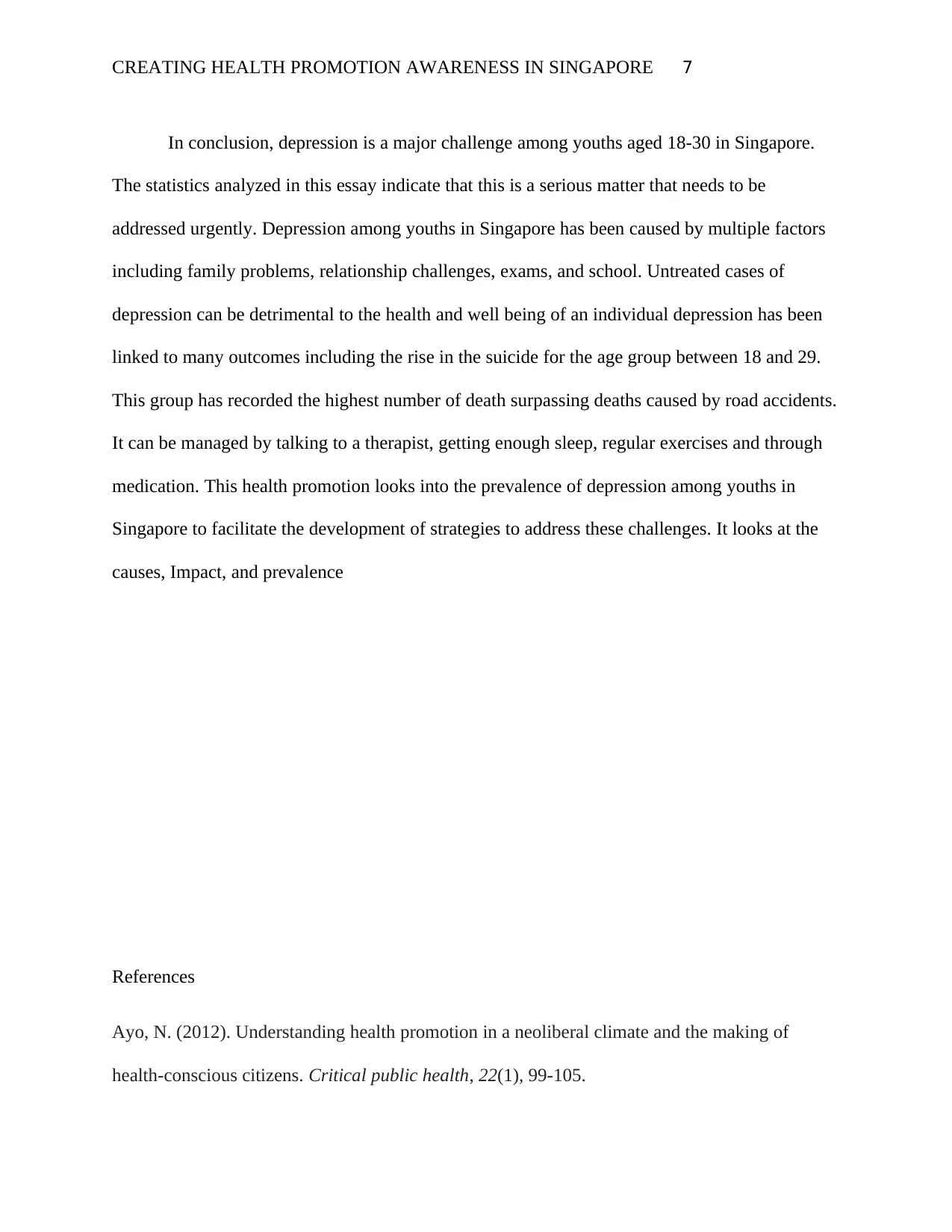
CREATING HEALTH PROMOTION AWARENESS IN SINGAPORE 7
In conclusion, depression is a major challenge among youths aged 18-30 in Singapore.
The statistics analyzed in this essay indicate that this is a serious matter that needs to be
addressed urgently. Depression among youths in Singapore has been caused by multiple factors
including family problems, relationship challenges, exams, and school. Untreated cases of
depression can be detrimental to the health and well being of an individual depression has been
linked to many outcomes including the rise in the suicide for the age group between 18 and 29.
This group has recorded the highest number of death surpassing deaths caused by road accidents.
It can be managed by talking to a therapist, getting enough sleep, regular exercises and through
medication. This health promotion looks into the prevalence of depression among youths in
Singapore to facilitate the development of strategies to address these challenges. It looks at the
causes, Impact, and prevalence
References
Ayo, N. (2012). Understanding health promotion in a neoliberal climate and the making of
health-conscious citizens. Critical public health, 22(1), 99-105.
In conclusion, depression is a major challenge among youths aged 18-30 in Singapore.
The statistics analyzed in this essay indicate that this is a serious matter that needs to be
addressed urgently. Depression among youths in Singapore has been caused by multiple factors
including family problems, relationship challenges, exams, and school. Untreated cases of
depression can be detrimental to the health and well being of an individual depression has been
linked to many outcomes including the rise in the suicide for the age group between 18 and 29.
This group has recorded the highest number of death surpassing deaths caused by road accidents.
It can be managed by talking to a therapist, getting enough sleep, regular exercises and through
medication. This health promotion looks into the prevalence of depression among youths in
Singapore to facilitate the development of strategies to address these challenges. It looks at the
causes, Impact, and prevalence
References
Ayo, N. (2012). Understanding health promotion in a neoliberal climate and the making of
health-conscious citizens. Critical public health, 22(1), 99-105.
Paraphrase This Document
Need a fresh take? Get an instant paraphrase of this document with our AI Paraphraser
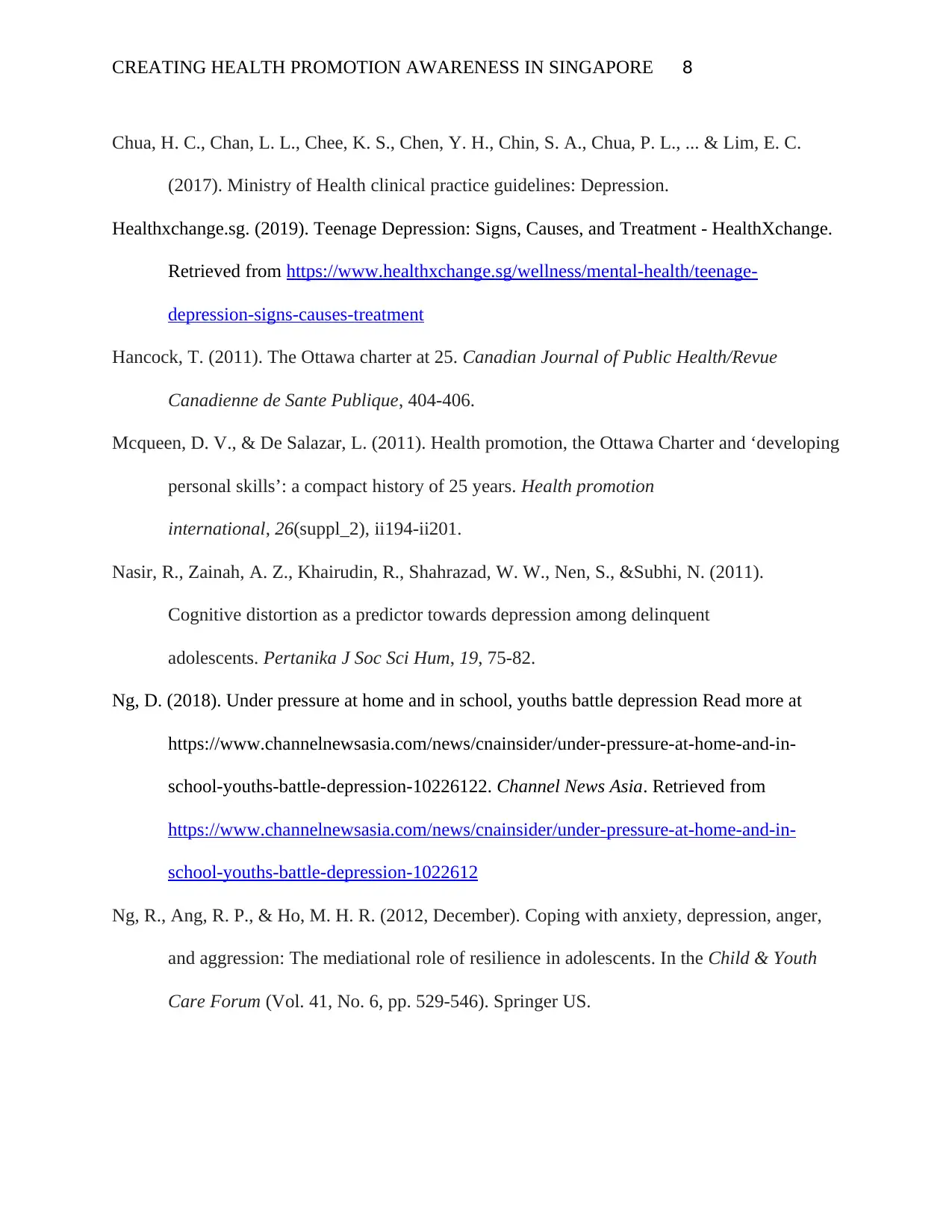
CREATING HEALTH PROMOTION AWARENESS IN SINGAPORE 8
Chua, H. C., Chan, L. L., Chee, K. S., Chen, Y. H., Chin, S. A., Chua, P. L., ... & Lim, E. C.
(2017). Ministry of Health clinical practice guidelines: Depression.
Healthxchange.sg. (2019). Teenage Depression: Signs, Causes, and Treatment - HealthXchange.
Retrieved from https://www.healthxchange.sg/wellness/mental-health/teenage-
depression-signs-causes-treatment
Hancock, T. (2011). The Ottawa charter at 25. Canadian Journal of Public Health/Revue
Canadienne de Sante Publique, 404-406.
Mcqueen, D. V., & De Salazar, L. (2011). Health promotion, the Ottawa Charter and ‘developing
personal skills’: a compact history of 25 years. Health promotion
international, 26(suppl_2), ii194-ii201.
Nasir, R., Zainah, A. Z., Khairudin, R., Shahrazad, W. W., Nen, S., &Subhi, N. (2011).
Cognitive distortion as a predictor towards depression among delinquent
adolescents. Pertanika J Soc Sci Hum, 19, 75-82.
Ng, D. (2018). Under pressure at home and in school, youths battle depression Read more at
https://www.channelnewsasia.com/news/cnainsider/under-pressure-at-home-and-in-
school-youths-battle-depression-10226122. Channel News Asia. Retrieved from
https://www.channelnewsasia.com/news/cnainsider/under-pressure-at-home-and-in-
school-youths-battle-depression-1022612
Ng, R., Ang, R. P., & Ho, M. H. R. (2012, December). Coping with anxiety, depression, anger,
and aggression: The mediational role of resilience in adolescents. In the Child & Youth
Care Forum (Vol. 41, No. 6, pp. 529-546). Springer US.
Chua, H. C., Chan, L. L., Chee, K. S., Chen, Y. H., Chin, S. A., Chua, P. L., ... & Lim, E. C.
(2017). Ministry of Health clinical practice guidelines: Depression.
Healthxchange.sg. (2019). Teenage Depression: Signs, Causes, and Treatment - HealthXchange.
Retrieved from https://www.healthxchange.sg/wellness/mental-health/teenage-
depression-signs-causes-treatment
Hancock, T. (2011). The Ottawa charter at 25. Canadian Journal of Public Health/Revue
Canadienne de Sante Publique, 404-406.
Mcqueen, D. V., & De Salazar, L. (2011). Health promotion, the Ottawa Charter and ‘developing
personal skills’: a compact history of 25 years. Health promotion
international, 26(suppl_2), ii194-ii201.
Nasir, R., Zainah, A. Z., Khairudin, R., Shahrazad, W. W., Nen, S., &Subhi, N. (2011).
Cognitive distortion as a predictor towards depression among delinquent
adolescents. Pertanika J Soc Sci Hum, 19, 75-82.
Ng, D. (2018). Under pressure at home and in school, youths battle depression Read more at
https://www.channelnewsasia.com/news/cnainsider/under-pressure-at-home-and-in-
school-youths-battle-depression-10226122. Channel News Asia. Retrieved from
https://www.channelnewsasia.com/news/cnainsider/under-pressure-at-home-and-in-
school-youths-battle-depression-1022612
Ng, R., Ang, R. P., & Ho, M. H. R. (2012, December). Coping with anxiety, depression, anger,
and aggression: The mediational role of resilience in adolescents. In the Child & Youth
Care Forum (Vol. 41, No. 6, pp. 529-546). Springer US.
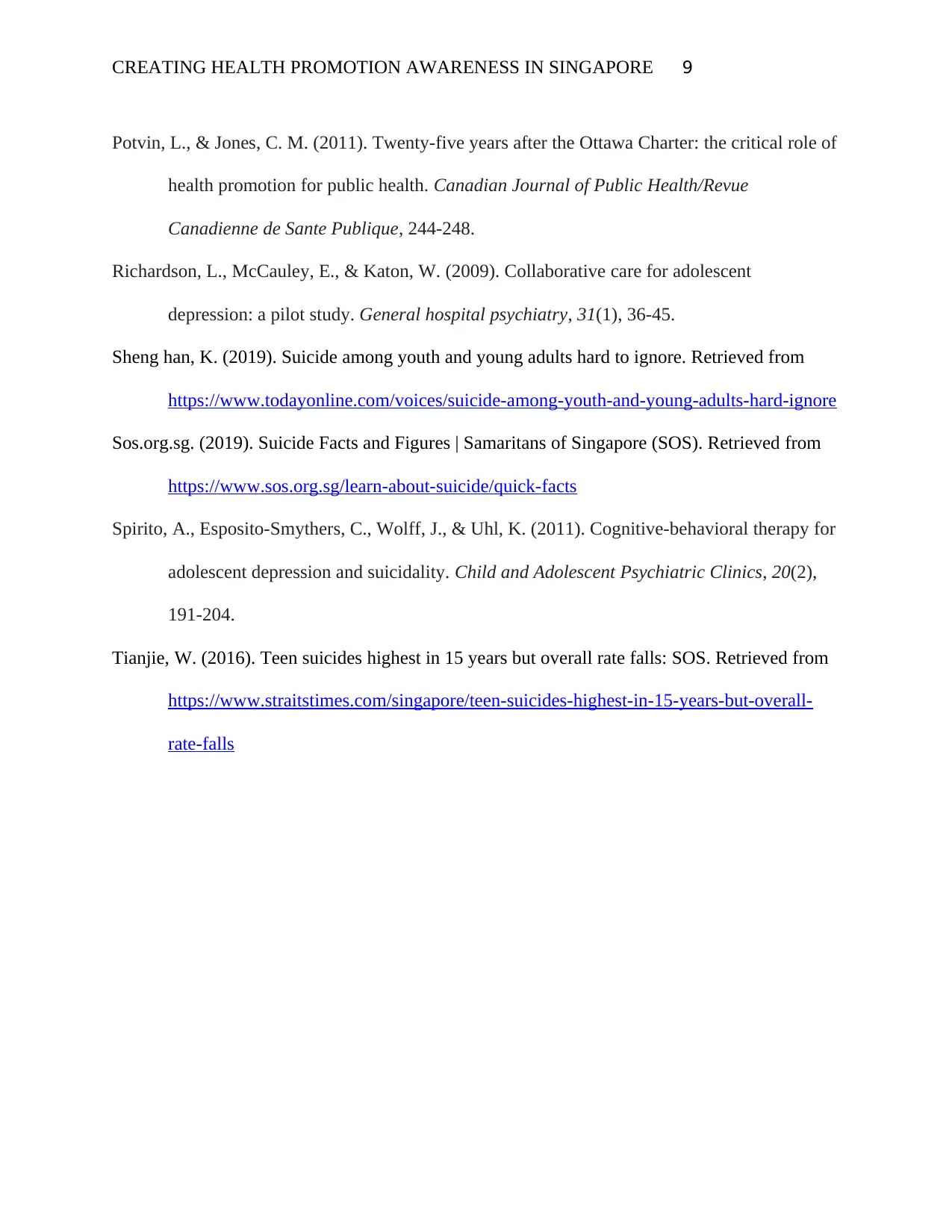
CREATING HEALTH PROMOTION AWARENESS IN SINGAPORE 9
Potvin, L., & Jones, C. M. (2011). Twenty-five years after the Ottawa Charter: the critical role of
health promotion for public health. Canadian Journal of Public Health/Revue
Canadienne de Sante Publique, 244-248.
Richardson, L., McCauley, E., & Katon, W. (2009). Collaborative care for adolescent
depression: a pilot study. General hospital psychiatry, 31(1), 36-45.
Sheng han, K. (2019). Suicide among youth and young adults hard to ignore. Retrieved from
https://www.todayonline.com/voices/suicide-among-youth-and-young-adults-hard-ignore
Sos.org.sg. (2019). Suicide Facts and Figures | Samaritans of Singapore (SOS). Retrieved from
https://www.sos.org.sg/learn-about-suicide/quick-facts
Spirito, A., Esposito-Smythers, C., Wolff, J., & Uhl, K. (2011). Cognitive-behavioral therapy for
adolescent depression and suicidality. Child and Adolescent Psychiatric Clinics, 20(2),
191-204.
Tianjie, W. (2016). Teen suicides highest in 15 years but overall rate falls: SOS. Retrieved from
https://www.straitstimes.com/singapore/teen-suicides-highest-in-15-years-but-overall-
rate-falls
Potvin, L., & Jones, C. M. (2011). Twenty-five years after the Ottawa Charter: the critical role of
health promotion for public health. Canadian Journal of Public Health/Revue
Canadienne de Sante Publique, 244-248.
Richardson, L., McCauley, E., & Katon, W. (2009). Collaborative care for adolescent
depression: a pilot study. General hospital psychiatry, 31(1), 36-45.
Sheng han, K. (2019). Suicide among youth and young adults hard to ignore. Retrieved from
https://www.todayonline.com/voices/suicide-among-youth-and-young-adults-hard-ignore
Sos.org.sg. (2019). Suicide Facts and Figures | Samaritans of Singapore (SOS). Retrieved from
https://www.sos.org.sg/learn-about-suicide/quick-facts
Spirito, A., Esposito-Smythers, C., Wolff, J., & Uhl, K. (2011). Cognitive-behavioral therapy for
adolescent depression and suicidality. Child and Adolescent Psychiatric Clinics, 20(2),
191-204.
Tianjie, W. (2016). Teen suicides highest in 15 years but overall rate falls: SOS. Retrieved from
https://www.straitstimes.com/singapore/teen-suicides-highest-in-15-years-but-overall-
rate-falls
⊘ This is a preview!⊘
Do you want full access?
Subscribe today to unlock all pages.

Trusted by 1+ million students worldwide
1 out of 9
Related Documents
Your All-in-One AI-Powered Toolkit for Academic Success.
+13062052269
info@desklib.com
Available 24*7 on WhatsApp / Email
![[object Object]](/_next/static/media/star-bottom.7253800d.svg)
Unlock your academic potential
Copyright © 2020–2025 A2Z Services. All Rights Reserved. Developed and managed by ZUCOL.





